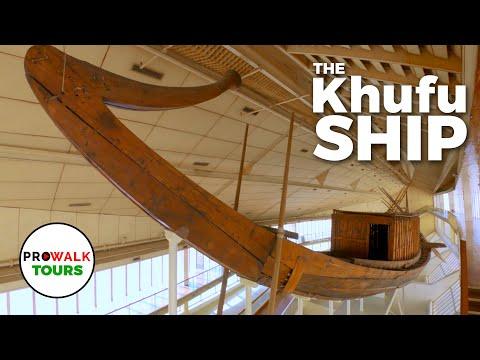I remember the first time I laid eyes on the Khufu Solar Ship; it was a moment of awe that defied my expectations. It was a clear day in Cairo, and the sun was blazing overhead as I approached the Ancient Egyptian Boat Museum, nestled quietly beside the Great Pyramid of Giza. I had heard whispers about this place, tales of a ship as old as the sands of Egypt, but nothing had prepared me for the grandeur that awaited inside.
The museum, though modest in size compared to the monumental pyramids nearby, had an air of reverence about it. As I walked through the entrance, the scent of aged wood and ancient history filled my senses. I felt a shiver run down my spine, as if the very essence of the past was greeting me. The staff, clad in traditional attire, greeted me with respectful nods and warm smiles, guiding me towards the exhibit that housed the legendary vessel.
The Khufu Solar Ship was more than just an ancient artifact; it was a symbol of the ancient Egyptians’ remarkable ingenuity and their profound connection to the divine. As I stepped into the exhibit hall, I was met with the sight of the ship, meticulously reconstructed and displayed under a protective glass dome. The ship, built over four thousand years ago, was an extraordinary sight to behold.
It was astonishing to see the ship’s grandeur up close. Its wooden planks, though ancient, were remarkably well-preserved, and the craftsmanship was nothing short of exquisite. The ship was about 43.6 meters long and 5.9 meters wide, which made it appear majestic even within the confines of the museum. I could hardly believe that this vessel had once been meant for Pharaoh Khufu, the builder of the Great Pyramid, to sail the heavens in the afterlife.
The exhibit provided a detailed account of the ship’s discovery and restoration. It had been buried in a pit near the Great Pyramid, forgotten for millennia until its rediscovery in 1954 by the Egyptian archaeologist Kamal el-Mallakh. It was a remarkable archaeological find, revealing insights into ancient Egyptian construction techniques and their spiritual beliefs. The ship was intended to carry the pharaoh into the afterlife, reflecting the Egyptians’ belief in the sun god Ra and the journey to the next world.
Standing there, I was struck by the craftsmanship of the ship. The wooden planks were joined together using an intricate system of lashing and pegging, demonstrating a level of precision and skill that was awe-inspiring. The ship’s bow was adorned with a carved head of a lion, symbolizing strength and protection. The attention to detail in every aspect of the ship’s design spoke volumes about the reverence with which the ancient Egyptians approached their burial practices.
As I explored the exhibit, I could see the models and diagrams that illustrated how the ship was believed to be used. There were depictions of the ship setting sail across the celestial waters, carrying the pharaoh on a divine voyage. The museum’s curator explained that the ship was not just a vessel for travel but a symbol of rebirth and eternal life. It was meant to accompany the pharaoh on his journey through the afterlife, a journey that would lead him to the sun god Ra and ensure his immortality.
I was fascinated by the stories and legends surrounding the ship. It was said that the ship’s journey was a reflection of the pharaoh’s transition from mortal life to the divine realm. The ship was a key component of the ancient Egyptians’ elaborate funerary rituals, which were designed to ensure that the pharaoh’s soul would be protected and guided throughout the afterlife.
The museum had also preserved various artifacts related to the ship, including tools used in its construction and small models of boats that might have been used in similar ceremonies. Each item was a piece of a larger puzzle, providing a glimpse into the complex rituals and beliefs of ancient Egypt. I was particularly intrigued by a set of small, intricately decorated figurines that were believed to represent the crew of the ship. These figures were meant to serve the pharaoh in the afterlife, ensuring that his journey was smooth and successful.
As I walked around the exhibit, I couldn’t help but imagine what it would have been like to witness the ship’s launch thousands of years ago. I envisioned a grand procession, with priests and dignitaries gathered to honor the pharaoh. The ship, resplendent and majestic, would have been the centerpiece of the ceremony, symbolizing the pharaoh’s divine journey and his eternal connection to the gods.
The museum also featured a multimedia presentation that brought the story of the Khufu Solar Ship to life. Through a combination of narration, animations, and visual effects, I was transported back in time to the era of the ancient Egyptians. The presentation vividly depicted the ship’s construction, its ceremonial use, and its role in the pharaoh’s afterlife journey. It was an immersive experience that deepened my appreciation for the significance of the ship and the culture that created it.
As my visit came to an end, I left the museum with a profound sense of connection to the ancient world. The Khufu Solar Ship was not just a relic of the past but a testament to the ingenuity and spiritual depth of the ancient Egyptians. It was a reminder of how deeply the past can resonate with the present, and how the artifacts of history can bridge the gap between different eras and cultures.
Leaving the museum, I felt as if I had been part of something timeless and extraordinary. The Khufu Solar Ship had left an indelible mark on my soul, and I knew that I would carry the memory of this incredible journey with me forever.
